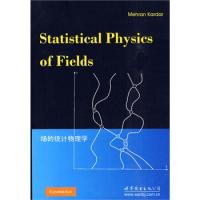| 定價: | ¥ 59 | ||
| 作者: | (美)卡達 著 | ||
| 出版: | 世界圖書出版公司 | ||
| 書號: | 9787510005664 | ||
| 語言: | 英文原版 | ||
| 日期: | 2010-04-01 | ||
| 版次: | 1 | 頁數: | 359 |
| 開本: | 16開 | 查看: | 290次 |

| 服務商城 | 客服電話 | 配送服務 | 優惠價 | 購買 |
| 400-711-6699 | 滿29至69元,免運費! | ¥47.2 |
Introduction、The Landau-Ginzburg Hamiltonian、Saddle point approximation, and mean-field theory、Continuous symmetry breaking and Goldstone modes、Discrete symmetry breaking and domain walls、Fluctuations、Scattering and fluctuations、Correlation functions and susceptibilities、Lower critical dimension、Comparison to experiments、Gaussian integrals等等。
Preface
1 Collective behavior, from particles to fields
1.1 Introduction
1.2 Phonons and elasticity
1.3 Phase transitions
1.4 Critical behavior
Problems
2 Statistical fields
2.1 Introduction
2.2 The Landau-Ginzburg Hamiltonian
2.3 Saddle point approximation, and mean-field theory
2.4 Continuous symmetry breaking and Goldstone modes
2.5 Discrete symmetry breaking and domain walls
Problems
3 Fluctuations
3.1 Scattering and fluctuations
3.2 Correlation functions and susceptibilities
3.3 Lower critical dimension
3.4 Comparison to experiments
3.5 Gaussian integrals
3.6 Fluctuation corrections to the saddle point
3.7 The Ginzburg criterion
Problems
4 The scaling hypothesis
4.1 The homogeneity assumption
4.2 Divergence of the correlation length
4.3 Critical correlation functions and self-similarity
4.4 The renormalization group (conceptual)
4.5 The renormalization group (formal)
4.6 The Gaussian model (direct solution)
4.7 The Gaussian model (renormalization group)
Problems
5 Perturbative renormalizafion group
5.1 Expectation values in the Gaussian model
5.2 Expectation values in perturbation theory
5.3 Diagrammatic representation of perturbation theory
5.4 Susceptibility
5.5 Perturbative RG (first order)
5.6 Perturbative RG (second order)
5.7 The e-expansion
5.8 Irrelevance of other interactions
5.9 Comments on the e-expansion
Problems
6 Lattice systems
6.1 Models and methods
6.2 Transfer matrices
6.3 Position space RG in one dimension
6.4 The Niemeijer-van Leeuwen cumulant approximation
6.5 The Migdal-Kadanoff bond moving approximation
6.6 Monte Carlo simulations
Problems
7 Series expansions
7.1 Low-temperature expansions
7.2 High-temperature expansions
7.3 Exact solution of the one-dimensional Ising model
7.4 Self-duality in the two-dimensional Ising model
7.5 Dual of the three-dimensional Ising model
7.6 Summing over phantom loops
7.7 Exact free energy of the square lattice Ising model
7.8 Critical behavior of the two-dimensional Ising model
Problems
8 Beyond spin waves
8.1 The nonlinear tr model
8.2 Topological defects in the XY model
8.3 Renormalization group for the Coulomb gas
8.4 Two-dimensional solids
8.5 Two-dimensional melting
Problems
9 Dissipative dynamics
9.1 Brownian motion of a particle
9.2 Equilibrium dynamics of a field
9.3 Dynamics of a conserved field
9.4 Generic scale invariance in equilibrium systems
9.5 Non-equilibrium dynamics of open systems
9.6 Dynamics of a growing surface
10 Directed paths in random media
10.1 Introduction
10.2 High-T expansions for the random-bond Ising model
10.3 The one-dimensional chain
10.4 Directed paths and the transfer matrix
10.5 Moments of the correlation function
10.6 The probability distribution in two dimensions
10.7 Higher dimensions
10.8 Random signs
10.9 Other realizations of DPRM
10.10 Quantum interference of strongly localized electrons
10.11 The locator expansion and forward scattering paths
10.12 Magnetic field response
10.13 Unitary propagation
10.14 Unitary averages
Solutions to selected problems
Chapter 1
Chapter 2
Chapter 3
Chapter 4
Chapter 5
Chapter 6
Chapter 7
Chapter 8
Index
1 Collective behavior, from particles to fields
1.1 Introduction
1.2 Phonons and elasticity
1.3 Phase transitions
1.4 Critical behavior
Problems
2 Statistical fields
2.1 Introduction
2.2 The Landau-Ginzburg Hamiltonian
2.3 Saddle point approximation, and mean-field theory
2.4 Continuous symmetry breaking and Goldstone modes
2.5 Discrete symmetry breaking and domain walls
Problems
3 Fluctuations
3.1 Scattering and fluctuations
3.2 Correlation functions and susceptibilities
3.3 Lower critical dimension
3.4 Comparison to experiments
3.5 Gaussian integrals
3.6 Fluctuation corrections to the saddle point
3.7 The Ginzburg criterion
Problems
4 The scaling hypothesis
4.1 The homogeneity assumption
4.2 Divergence of the correlation length
4.3 Critical correlation functions and self-similarity
4.4 The renormalization group (conceptual)
4.5 The renormalization group (formal)
4.6 The Gaussian model (direct solution)
4.7 The Gaussian model (renormalization group)
Problems
5 Perturbative renormalizafion group
5.1 Expectation values in the Gaussian model
5.2 Expectation values in perturbation theory
5.3 Diagrammatic representation of perturbation theory
5.4 Susceptibility
5.5 Perturbative RG (first order)
5.6 Perturbative RG (second order)
5.7 The e-expansion
5.8 Irrelevance of other interactions
5.9 Comments on the e-expansion
Problems
6 Lattice systems
6.1 Models and methods
6.2 Transfer matrices
6.3 Position space RG in one dimension
6.4 The Niemeijer-van Leeuwen cumulant approximation
6.5 The Migdal-Kadanoff bond moving approximation
6.6 Monte Carlo simulations
Problems
7 Series expansions
7.1 Low-temperature expansions
7.2 High-temperature expansions
7.3 Exact solution of the one-dimensional Ising model
7.4 Self-duality in the two-dimensional Ising model
7.5 Dual of the three-dimensional Ising model
7.6 Summing over phantom loops
7.7 Exact free energy of the square lattice Ising model
7.8 Critical behavior of the two-dimensional Ising model
Problems
8 Beyond spin waves
8.1 The nonlinear tr model
8.2 Topological defects in the XY model
8.3 Renormalization group for the Coulomb gas
8.4 Two-dimensional solids
8.5 Two-dimensional melting
Problems
9 Dissipative dynamics
9.1 Brownian motion of a particle
9.2 Equilibrium dynamics of a field
9.3 Dynamics of a conserved field
9.4 Generic scale invariance in equilibrium systems
9.5 Non-equilibrium dynamics of open systems
9.6 Dynamics of a growing surface
10 Directed paths in random media
10.1 Introduction
10.2 High-T expansions for the random-bond Ising model
10.3 The one-dimensional chain
10.4 Directed paths and the transfer matrix
10.5 Moments of the correlation function
10.6 The probability distribution in two dimensions
10.7 Higher dimensions
10.8 Random signs
10.9 Other realizations of DPRM
10.10 Quantum interference of strongly localized electrons
10.11 The locator expansion and forward scattering paths
10.12 Magnetic field response
10.13 Unitary propagation
10.14 Unitary averages
Solutions to selected problems
Chapter 1
Chapter 2
Chapter 3
Chapter 4
Chapter 5
Chapter 6
Chapter 7
Chapter 8
Index





 粵公網安備 44030902003195號
粵公網安備 44030902003195號